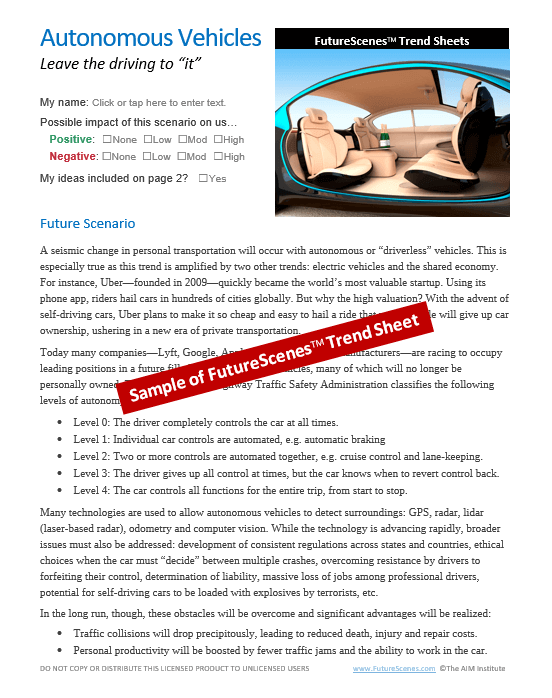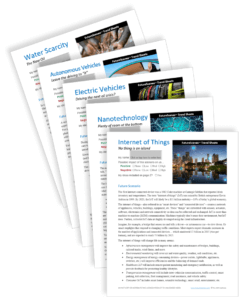FutureScenes® Trend Sheets
Note: Futurescenes Trend Sheets were last updated in 2017, and The AIM Institute is no longer supporting this free offering. You can still request them using the form below, and may wish to update them yourself.
Working on your strategy? Hosting an ideation event? Building a future-oriented culture? These FutureScenes views of tomorrow will engage your team and focus your business on what will be. (This is a free service of The AIM Institute, part of our mission to help B2B businesses innovate.)
Future Insight as a Competitive Weapon
How well does your business understand the future when developing strategy or new products? Future scenario planning has never been more important… for three reasons.
- Foresight Wins Battles: In their classic, Competing for the Future, Hamel and Prahalad explained three stages of competition: 1) competing for industry foresight, 2) competing to build capabilities for that future, and 3) competing for market share. Companies that just “show up” in Stage 3 have already lost to prepared competitors.
- The Future is Knowable: OK, so we never got those flying cars. But in The Inevitable, Kevin Kelly argues that when we understand the intrinsic nature of technologies, we can confidently predict the future. Example: The dangerous nature of steam power predestined our 1800’s shift from cottage industries to factories.
- Change is Swift & Punishing: Observe Uber, Amazon, Tesla, Apple: Today, barriers to competition look like invitations to disruption. If you make physical products, someone may “Uber” you by surrounding their product with amazing services based on the internet-of-things and artificial intelligence. Maybe soon.
FutureScenes Trend Sheets
NOTE: FUTURESCENES TREND SHEETS WERE LAST UPDATED IN 2017, AND THE AIM INSTITUTE IS NO LONGER SUPPORTING THIS FREE OFFERING. YOU CAN STILL REQUEST THEM USING THE FORM BELOW, AND MAY WISH TO UPDATE THEM YOURSELF.
You can help your team “visit the future” with 16 FutureScenes sheets. Each two-page overview quickly makes you aware and conversant about your future. While not exhaustive, they trigger fresh thinking and show you where to dig deeper. Planning an idea-generation session? Distribute these beforehand and tell participants their “admission ticket” is returning 3 or 4 sheets with their ideas. These sheets can trigger game-changing thinking before and during your ideation event. Each sheet is a Microsoft Word® form, so employees can score the scenario’s positive or negative impact on their business.
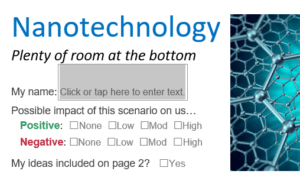
Each FutureScenes trend sheet includes broad implications for businesses in general. On page 2, your people can record implications and ideas for your business.
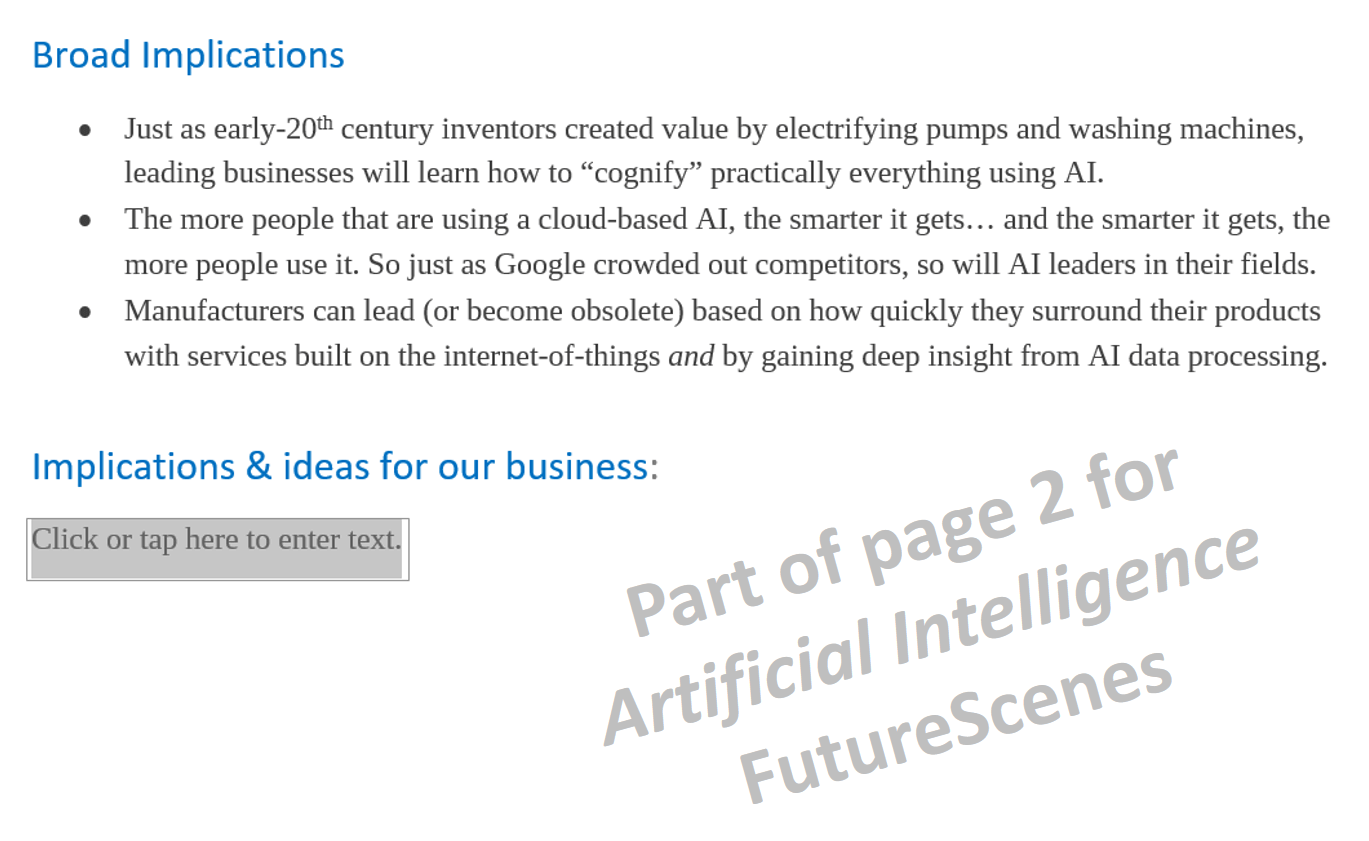
Other uses? Distribute a new FutureScenes sheet weekly. You’ll build a forward-thinking culture and give employees “raw material” for exciting innovation. Are you conducting secondary market research? Don’t just consider what has happened. Consider what will happen.
Ready to get started?
Fill out the form below for your set of free FutureScenes Trend Sheets. You’ll get a zipped file with all 16 sheets in Microsoft Word document form. Each sheet is a protected “form” so it will stay intact except for the places employees fill in:
- the possible impact of this trend on your business (pg.1)
- possible implications of this trend on your business (pg.2)
Is your business ready for these trends?
You may be tempted to “spoon-feed” employees with just those scenarios you think are relevant. But future trends have many non-obvious implications no single person can imagine. Better to “crowd source” idea generation by exposing employees to a variety of future scenarios (using FutureScenes sheets). Consider this small sampling of possible upsides and downsides…
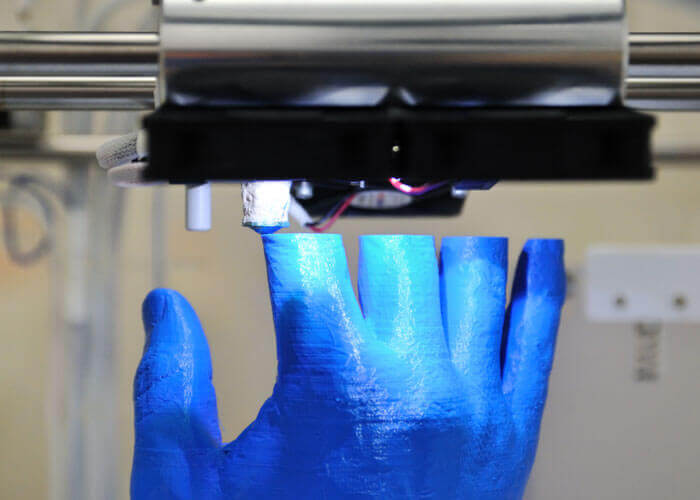
Polymers: You begin developing dedicated 3D-printable polymers for mass customization of medical products.
Electrical motors: You suffer shrinking demand in your milling machine market as additive manufacturing overtakes subtractive manufacturing.

Photovoltaics: You develop low cost products ideally suited for the booming off-grid solar-power revolution in Africa.
Textile chemicals: While you focus on Asia, competitors seize share in African textiles, which is rapidly growing due to low labor costs.

Diversified corporation: You tip your portfolio to lifestyle service businesses, knowing aging populations spend more on services than products.
Publishing: You focus too long on school books (declining), when you should invest in elderly health publications (growing).

Banking: You develop a natural language processing AI-bot that performs banking services and guides development of new services.
Radiology: Demand for medical testing declines as more effective AI-based diagnoses eliminate most “just-in-case” testing.

Entertainment: You take a leading position in designing entertainment systems perfectly suited for driverless vehicles.
Construction coatings: Demand for parking lots—and your coatings—decreases as commuters move to Uber-based autonomous vehicles.

Plastic: Your company is the first to commercially produce sustainable acrylic from microbes instead of non-renewable petroleum feedstocks.
Surfactants: Your oil-derived surfactant is losing market share to one produced by engineered microorganisms that digest agricultural waste.

HVAC: You optimize a heating system for electric car cabins… which lack the heat source of internal combustion engines.
Gears: Sales into the automotive transmission market are dropping rapidly, since electric vehicles have no transmission.

Capacitors: Your early involvement with UltraBattery design in Australia puts you in the leading supply position for this growth market.
Pumps: Your competitor’s patents for a high-efficiency turbine/pump block your entrance into the pumped-storage hydroelectricity market.

Shipping: You have negotiated all the port contracts needed to take advantage of newly ice-free shipping lanes in the Arctic.
Regulation: Your failure to reduce emissions puts you in a “buy” position instead of “sell” with new cap-and-trade regulations.

Robotics: You patent multi-purpose robotics for grape pruning, weeding, and harvesting for the wine industry.
Pesticides: Sales are dropping rapidly from 1) precision satellite farming, 2) pest-resistant biotech crops, and 3) sustainable farming.

Actuators: Sales are off the chart because your new family of actuators contains a suite of sensors that easily connect to the IoT.
Packaging equipment: You lose market share to a competitor’s product with predictive maintenance and package monitoring.

Water filters: You commercialize the first graphene-based water filtration system, which allows much faster throughput than traditional filters.
Batteries: A competitor introduces a battery with much higher energy density, based on nanocrystalline nickel and metal hydrides.

Control systems: Thanks to early and focused R&D, your wind turbine monitoring and predictive maintenance system is the market leader.
Ship-building: Demand for new crude-oil tankers is down as more energy is supplied by local renewable sources, e.g. solar and wind.

Hydraulic cylinders: You build a leading position supplying hydraulic components to robot OEMs and the robot aftermarket.
Protective gear: Demand drops for work uniforms, hard hats, and eye protection as robots replace more factory workers.

Software: Demand grows for your smart-city software, which provides adaptive bus routing, traffic light timing, streetlight intensity, etc.
Retail: Per-store sales decline in rural areas as populations migrate to cities, and especially to mega-cities.

Reverse-osmosis: Your high-volume filtration system sees increased global use in purifying brackish and polluted water.
Agro-business: Your farms in the plains states suffer increasing water costs, as underground aquifer levels drop to critical levels.
